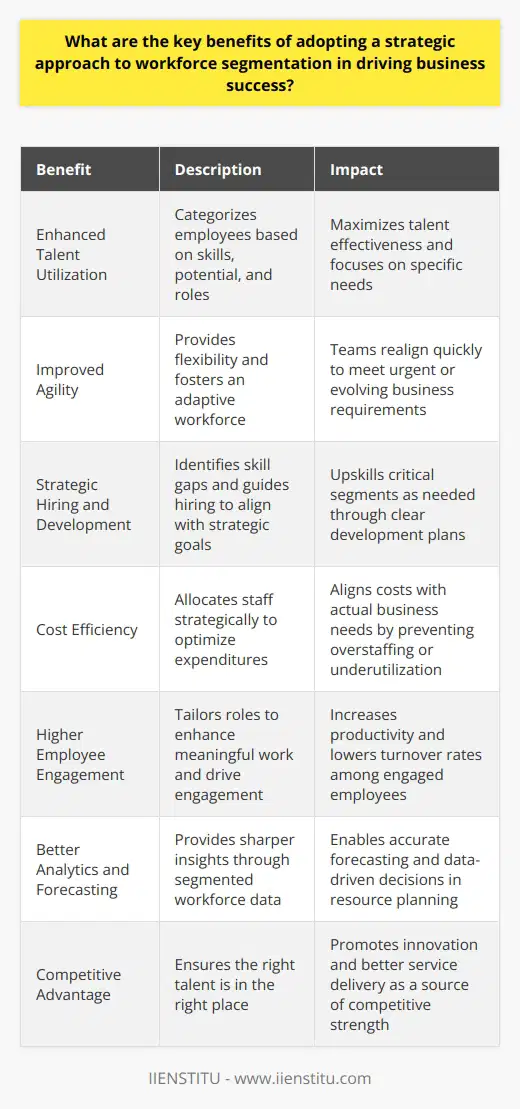
In today's competitive business environment, organizations are continually seeking methodologies to enhance efficiency and maintain a competitive edge. One such strategy that is gaining traction among forward-thinking companies is workforce segmentation. This analytical approach to human resource management allows businesses to align their talent management practices with their overall business strategies meticulously. Understanding and implementing workforce segmentation can lead to significant improvements in productivity and job satisfaction, therefore pushing businesses towards greater success.
This blog will explore the concept of workforce segmentation, its evolution, practical applications, implementation strategies, and potential implications for the modern workplace.
Understanding Workforce Segmentation
Workforce segmentation is not a new concept; however, its application and scope have evolved with the advent of sophisticated analytics and an intensified focus on strategic human resource management. As businesses adapt to global competition and technological change, the need for a segmented workforce becomes increasingly apparent.
Segmentation enables companies to identify unique groups within their workforce, tailoring management and development approaches to the specific characteristics and needs of each segment.
Brief history and evolution
The practice of workforce segmentation has its roots in marketing, where customer segmentation has long been used to tailor products and services to different consumer groups. The crossover into HR management has led to the adoption and refinement of similar segmentation techniques but focused on the diversity within the workforce. Traditionally, employees were often managed as a monolithic group, but segmentation recognizes the uniqueness of individual contributors and the need for differentiated management.
Need for Workforce Segmentation
The core benefits of workforce segmentation include improved alignment of employee capabilities with business requirements, enhanced talent attraction and retention, and more effective workforce planning. The practical challenges, however, are considerable. Organizations must grapple with the complexity of data analysis, the resources needed to design tailored programs, and the potential for perceived inequity among employees.
Collaborative Planning Forecasting And Replenishment Benefits And İmplementation
Managing Employee Grievances And Discipline İn Large Corporations
Segmentation variables
HR Literature: Evaluating its Influence on Organizational Success
Virtual Management: Adapting to the Telecommuting Revolution
HR Employee Turnover Analysis: Key Strategies and Implications
Corporate HR Aligns Div/Unit HR: Guiding to Implement Plans Effectively
Variables used for workforce segmentation generally fall into three primary categories: demographics (such as age, gender, and ethnicity), skill levels (including qualifications and experience), and job roles (encompassing responsibilities and functions). By understanding these variables, businesses can craft more targeted HR strategies that boost performance and employee engagement.
Approaches to Workforce Segmentation
Strategic Workforce Segmentation
In strategic workforce segmentation, businesses categorize employees based on their strategic value and potential impact on organizational goals. This approach often prioritizes roles that drive competitive advantage or are critical to business operations. The significance of strategic workforce segmentation lies in its ability to inform decision-making regarding resource allocation, talent development, and succession planning. A case study exemplifying this might involve a technology firm that segments its workforce to focus intensely on its R&D department—a high-value area integral to the company's innovation and market positioning.
Role-based Workforce Segmentation
Alternatively, role-based workforce segmentation scrutinizes the various job functions within an organization to determine specific management and support needs. This method recognizes that different roles may require distinct types of motivation, training, and rewards. Highlighting the significance of this approach, a service-based organization might segment its customer-facing employees to provide them with specialized service skill training, recognizing their role's direct impact on customer satisfaction and loyalty.
Performance-based Workforce Segmentation
Lastly, performance-based workforce segmentation focuses on individual employee performance metrics. Here, top performers might be provided with additional opportunities for growth and development, while those needing improvement receive targeted coaching or training. The significance of this segmentation lies in optimizing the contribution of each employee to the organization's mission.
A case study could spotlight a sales enterprise that segments its workforce based on sales figures, thus identifying key sales personnel for advanced skills training and incentive programs.
Risk Mitigation Strategies For Successful Project Management
Optimal Business Organization Strategies For Competitive Advantage
Implementation and Application of Workforce Segmentation
To implement workforce segmentation effectively, organizations must follow a structured approach. This begins with clear segmentation criteria, comprehensive data collection, and analysis that inform the segments' creation. Then, HR policies and programs can be adapted to meet the specific needs of each segment.
Steps in implementing workforce segmentation
A fundamental step in applying workforce segmentation is a thorough analysis of the existing workforce based on pre-determined segmentation variables. Following this analysis, actionable strategies and tailor-made programs are developed.
Role of technology and AI in workforce segmentation
The role of technology, particularly artificial intelligence (AI), is pivotal in modern workforce segmentation strategies. Machine learning algorithms and predictive analytics can process complex datasets, revealing patterns and trends that inform segmentation. Additionally, AI can help in monitoring the effectiveness of targeted HR strategies over time.
Real-life examples of successful implementation
Many companies have achieved notable improvements by applying workforce segmentation. For example, a multinational corporation may use geographic segmentation to differentiate HR practices across its global offices, accommodating varying cultural and regulatory environments.
Potential challenges and solutions
Challenges to implementing workforce segmentation include resistance to change, data privacy concerns, and the requirement for ongoing management commitment. Solutions encompass clear communication, robust data governance policies, and leadership training to bolster the required cultural shift within the organization.
Implications of Workforce Segmentation
Significant implications of workforce segmentation are evident in business operations, especially concerning productivity and employee engagement. By segmenting the workforce, organizations can develop a deep understanding of their human capital, enabling tailored strategies that leverage individual strengths while mitigating weaknesses.
Improving productivity and performance
Workforce segmentation has the potential to dramatically improve productivity by ensuring that the right people are in the right roles with the appropriate support. This strategic fit maximizes both individual and organizational performance.
Enhancing employee engagement and satisfaction
Employee engagement and satisfaction tend to increase when individuals feel recognized and valued for their unique contributions. Workforce segmentation facilitates this by providing more personalized career development and reward systems.
Future of work and changing job landscape
It is impossible to discuss workforce segmentation without considering the future implications of demographic shifts and technological advancements. The impact of these changes necessitates the continual evolution of segmentation methods to remain effective and relevant.
Impact of demographic changes
With an aging population in certain regions and millennials making up the largest generation in the workforce, companies need to adjust their segmentation strategies to address these demographic changes.
Impact of technological advancements
Similarly, technological advancements such as automation and AI influence the types of roles and skills needed within an organization. Workforce segmentation helps businesses adapt to these shifts by reevaluating which segments will be most crucial for future success.
Workforce segmentation represents a critical tool in the arsenal of contemporary business strategists. By thoroughly analyzing and categorizing their workforce, businesses can craft nuanced and effective HR policies that drive success. Implementing such strategies may come with challenges, but the benefits — improved productivity, increased employee satisfaction, and a more agile response to market changes — are too substantial to ignore.
We encourage company leaders and HR professionals to delve further into workforce segmentation and consider how this approach can be integrated within their organizations. Embracing a strategic framework for talent management is not a mere option but a necessity for achieving and sustaining a competitive edge in today's dynamic business landscape.
Frequently Asked Questions
What are the key benefits of adopting a strategic approach to workforce segmentation in driving business success?
Strategic Workforce Segmentation: A Path to Business Success
Enhanced Talent Utilization
Workforce segmentation tailors roles to specific needs. It categorizes employees based on their skills, potential, and roles. This focused approach maximizes talent effectiveness.
Improved Agility
Businesses must adapt swiftly. Segmentation provides flexibility, fostering an adaptive workforce. Teams realign quickly, meeting urgent or evolving business requirements.
Strategic Hiring and Development
Segmentation identifies skill gaps. It guides hiring, ensuring resource alignment with strategic goals. Development plans become clear, upskilling critical segments as needed.
Cost Efficiency
Allocating staff strategically optimizes expenditures. It prevents overstaffing or underutilization, balancing demand and supply. This aligns costs with actual business needs.
Higher Employee Engagement
Employees yearn for meaningful work. Tailored roles enhance this, driving engagement. Engaged employees show higher productivity and lower turnover rates.
Better Analytics and Forecasting
Segmented workforce data yields sharper insights. They enable accurate forecasting and data-driven decisions. Analytics thus become a powerful tool in resource planning.
Competitive Advantage
A well-segmented workforce becomes a source of competitive strength. It ensures the right talent is in the right place, promoting innovation and better service delivery.

How can companies effectively implement workforce segmentation to ensure a cohesive and productive work environment?
Identifying Workforce Segments
First, companies must identify distinct employee groups. Consider skills, roles, and functions. Diversity in workforce segmentation requires acknowledging the varying needs and contributions of different employee groups. Start with organizational analysis. Map out departments, teams, and clusters. Recognize who works together and how.
Understanding Employee Needs
Workforce segmentation hinges on understanding needs. Engage with employees across the spectrum. Use surveys, interviews, and feedback tools. Solicit input on work preferences and requirements. Assess technology use, workspace design, and support services. These insights pave the way for targeted strategies.
Creating Tailored Strategies
Develop strategies that reflect segmentation discoveries. For example:
- Remote workers may need virtual collaboration tools.
- Onsite employees might require ergonomic workspaces.
- Part-time staff could benefit from flexible scheduling.
Adapt approaches to fit the workforce’s diverse landscapes.
Fostering Communication and Collaboration
Ensure clear, open lines of communication. Use platforms that bridge different segments. Integrate collaboration tools for seamless team interactions. Agile communication fosters a cohesive work environment.
Investing in Management Training
Management requires segment-specific training. Teach leaders to understand and manage diverse employee groups. Equip them with skills to handle each segment’s nuances. Strong leadership propels productivity.
Monitoring and Adapting
Regularly review workforce segmentation outcomes. Scrutinize productivity data, employee satisfaction, and operational efficiency. Modify strategies as the company evolves. Stay flexible and responsive to changing workforce dynamics.
Promoting Inclusivity and Respect
Workforce segmentation must not create division. Instead, nurture an inclusive culture. Celebrate diverse contributions. Encourage respect among different employee groups.
Ensuring Legal and Ethical Compliance
Companies must comply with employment regulations. Ensure no segment faces discrimination. Uphold ethical standards in all segmentation practices.
Effectively segmenting the workforce involves careful planning and continuous refinement. It relies on understanding employee needs and delivering tailored solutions. This strategy strengthens productivity and fosters a cohesive work environment.

In the context of fast-paced business environments and diverse workforces, what are the challenges faced in successful workforce segmentation and how can they be overcome?
Workforce Segmentation in Modern Business
Challenges in Segmentation
In fast-paced business environments, workforce segmentation faces unique challenges. Diverse workforces complicate this process. They demand nuanced understanding and agile strategies.
Diversity and Complexity
Workforces today are diverse. They consist of varying demographics, skills, and expectations. This diversity requires tailored segmentation approaches. One-size-fits-all strategies fail in such landscapes.
Rapid Change
Business worlds evolve swiftly. Workforce needs change in tandem. This dynamism challenges static segmentation models. It demands flexibility and continual reassessment.
Data Overload
Companies collect vast quantities of data. Parsing this data for segmentation proves overwhelming. Yet, actionable insights are crucial. They guide effective workforce management.
Communication Barriers
Effective segmentation relies on clear communication. Diverse workforces bring diverse communication styles. This variety can impede mutual understanding. It can thwart effective segmentation efforts.
Integration with Business Goals
Segmentation must align with overarching business goals. Misalignment can lead to strategic dissonance. It can dilute the impact of workforce efforts.
Strategies to Overcome Challenges
Prioritize Flexibility
Embrace change as a constant. Design segmentation strategies for adaptability. This approach allows for quick pivoting as necessary.
Leverage Technology
Use advanced analytics tools. They help sift through complex data. Such tools make segmentation more manageable. They also unlock deeper insights.
Foster Inclusive Communication
Adapt communication to the workforce's diversity. Use clear, inclusive language. Encourage feedback to ensure comprehension. This fosters a collaborative environment.
Continuous Learning
Encourage a culture of ongoing learning. This builds a workforce adaptable to change. It benefits both employee development and segmentation refinement.
Align with Objectives
Ensure workforce segmentation supports business objectives. Constantly evaluate and realign strategies. This synergy enhances workforce contribution to business goals.
Takeaway
Success in workforce segmentation requires an agile, informed approach. It must consider the unique challenges of a diverse and dynamic workforce. With the right strategies, it is possible to create a segmentation that not only understands the complexities but also capitalizes on the strengths of a varied team. By prioritizing flexibility, leveraging technology, fostering inclusive communication, encouraging continuous learning, and aligning with business objectives, an organization can surmount the challenges and excel in segmentation. Such a focused approach promises to drive a business forward in an ever-changing corporate landscape.



